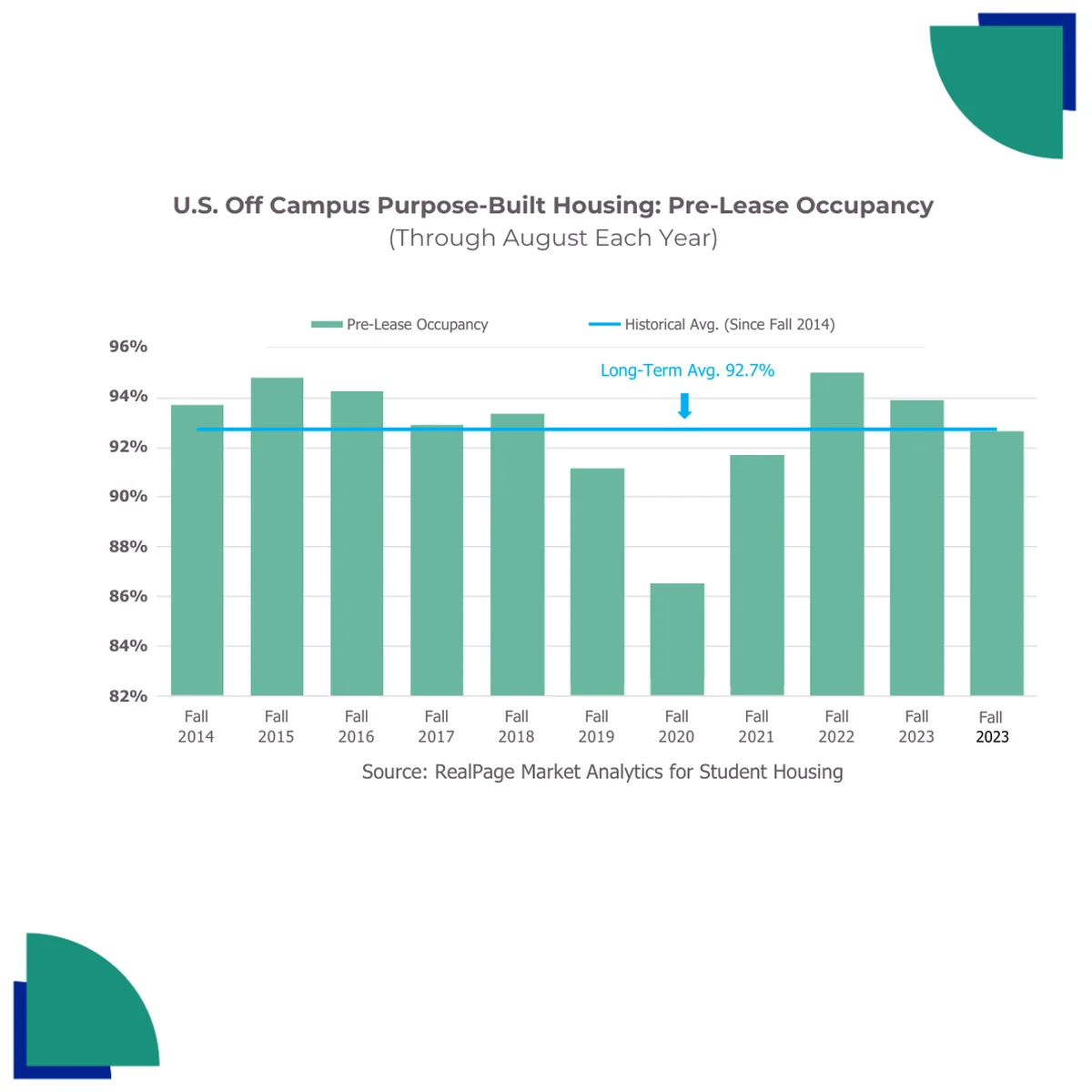18/11/2024
18/11/2024

KUWAIT CITY, November 18: A report issued by InvestGB, the investment arm of Gulf Bank, titled "Student Housing in the United States: From Cyclical to Sustainable Growth", provides an overview of the sector's dynamics, key drivers, and future outlook. The report highlights that the student housing sector has experienced strong occupancy rates, particularly in purpose-built properties near leading universities.
The report noted that while pre-leasing rates for 2024 were lower than the exceptional levels seen in 2022 and 2023, they remain in line with historical averages, reflecting a degree of stability amid economic uncertainty. This stability is attributed to Tier 1 universities, which maintain steady demand from students, according to data from RealPage.
Pre-Lease Occupancy Rates Remain Resilient
The student housing sector has exhibited robust occupancy rates, particularly in purpose-built properties near leading universities. RealPage’s data illustrates that although pre-leasing figures for 2024 trailed the exceptional rates of 2022 and 2023, they remain consistent with historical averages, reflecting a degree of stability amid economic uncertainty. The occupancy trend is particularly favorable at Tier 1 universities, which continue to attract consistent student demand.
Supply / Demand Dynamics
The limited availability of supply has significantly contributed to the recovery of the student housing market. PwC reports a 35% decline in the delivery of new student housing in the 2020s relative to the 2010s. The observed decline is noteworthy when viewed as a proportion of the current inventory levels. In Fall 2024, new deliveries accounted for 3% of the total student housing stock, marking a substantial decrease from the approximately 8% of annual additions seen over the past ten years. This has led to a contraction in supply.
Moreover, on the supply side, an increase in the availability of competitive student buildings (see footnote) may account for the decline in off-campus purpose-built student housing deliveries, as well as the slight softening in demand for the sector.
Enrollment Growth Trends
On the demand side, the observed trend of declining enrollment growth pre-2024 may be impacting the demand dynamics within the student housing market. Prior to 2024, overall enrollment experienced a modest decline; however, this year has witnessed a reversal. Preliminary data from the National Student Clearinghouse Research Center shows a 3% increase in undergraduate enrollment for Fall 2024, with growth being across all sectors. However, this overall increase contrasts with a 5% drop in freshman enrollment compared to last year, suggesting mixed signals. The drop in freshman enrollment raises concerns about the long-term demand for higher education among recent high school graduates. This trend may be influenced by various factors, including evolving views regarding college, economic constraints, or a movement towards alternative educational and career options. This combination of increasing overall enrollment with a declining freshman cohort introduces a level of uncertainty regarding the sustainability of growth in the forthcoming years.
Nevertheless, on a more granular level, data on RealPage’s 175 tracked campuses, which serve as a proxy for Tier 1 or Institutional-grade universities, shows that these institutions have sustained a more stable enrollment base compared to the broader U.S. enrollment figures. This suggests that there is a growing disparity among campuses, with the divergence in enrollment trends at the campus level largely influenced by robust growth at well-known institutions with strong brand recognition.
Rental Growth Rates Still Above Historical Norms
The student housing sector experienced a notable increase in rental growth in recent years, surpassing its historical averages. The effective asking rent changes for off-campus purpose-built housing have consistently exceeded the historical average of 2.6% on a year-over-year basis since Fall 2014, according to RealPage Analytics. Notably, Fall 2023 saw an exceptional rent growth of 7.8%, which is the highest annual increase recorded in this period. According to PwC’s 2025 Emerging Trends in Real Estate report, the student housing rent growth outpaced conventional multifamily in 34 of 56 months since early 2020, highlighting the sector's robust performance. The momentum continued into Fall 2024, with rent growth reaching 5.0%. Whilst still well above the long-term average, the sector is experiencing a normalization of rent growth. The increased availability of competitive student housing, as noted earlier, is another factor contributing to moderation of rent growth.
The data from RealPage above further supports the notion that convergence may be occurring between the broader multifamily sector and student housing markets.
According to PwC’s report, the U.S. student housing sector is transitioning into a more mature asset class, characterized by enhanced stability and predictability. The normalization and moderation in rental growth are typical of a mature market, where high volatility gives way to steady, income-focused performance. A key indicator of sector maturity is the shift from what PwC refers to as the "shakeout phase," a period characterized by an increase in market consolidation as competitive dynamics begin to stabilize. This, according to the report, post-shakeout phase is evident, with the majority of off-campus beds now under the control of the top 25-30 ownership groups. This level of consolidation aligns with a mature market profile, where larger players dominate and smaller operators are less prevalent.
Slowdown in transaction activity
The sector has also experienced a decline in transaction volume, largely attributed to rising interest rates and a more conservative lending landscape. Walker & Dunlop’s (W&D) data indicates that transaction activity in student housing dropped significantly in 2023, a 71% decline from the peak levels observed in 2022. This contraction is consistent with broader trends in real estate, where elevated borrowing costs have made it challenging for investors to obtain favorable financing terms.
As a result, transaction volume has shifted toward well-capitalized private investors and institutional players that have the capacity to allocate equity with minimal dependence on debt financing. W&D reports that private capital was the primary driver of transaction activity in 2023, accounting for around $5.7 billion in total sales. W&D adds that significant institutional investors are currently engaging in asset acquisitions within premier markets, focusing on purpose-built properties located near major campuses.
The recent rise in competitive student housing availability, coupled with a declining population of 18-24-year-olds, presents challenges for the sector. Going forward, investors should be more selective in their strategy. Prime markets are expected to maintain consistent occupancy levels and experience gradual rent increases, closer to their sustainable historical levels. Yardi Matrix projects that occupancy levels will stabilize at approximately 94-95% within major universities, reinforcing the sector's resilience in high-demand markets.
The capital markets outlook for student housing remains cautiously optimistic for high-quality assets near top universities. As lenders become more selective, financing is expected to concentrate on properties with stable occupancy and strong rental income, particularly in high-demand Tier 1 university markets.
Cap rates have adjusted upward to reflect higher interest rates, but we anticipate potential cap rate contraction as interest rates decline, creating a more favorable environment for refinancing and transaction activity.
Ultimately, for investors, the path forward lies in selective investment in high-demand markets. The sector is anticipated to sustain its position as a robust investment opportunity within the real estate market, offering investors appealing risk-adjusted returns.
Disclaimer: The content herein is intended to provide general information and does not constitute financial or investment advice. Readers are strongly encouraged to seek professional or specialist advice before making any investment decisions based on the information provided in this article. While every effort is made to ensure that the content is accurate, complete, and up-to-date, no representations, warranties, or guarantees, whether express or implied, are made regarding the accuracy, completeness, or timeliness of the information.
References
•tPwC. Emerging Trends in Real Estate 2025. Pages 68-69.
•tRealPage. Student Housing Webcast September 2024.
•tNational Student Clearinghouse Research Center. Preliminary Fall 2024 Enrollment Report. Available at: nscresearchcenter.org.
•tWalker & Dunlop. 2024 U.S. Student Housing Market Report.
•tBerkadia. 2024 U.S. Student Housing Market Report.
•tYardi Matrix. October 2024 Student Housing National Report.


